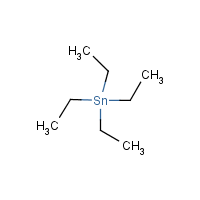Tetraethyl tin
Agent Name
Tetraethyl tin
CAS Number
597-64-8
Formula
C8-H20-Sn
Major Category
Metals

Synonyms
Stannane, tetraethyl-; Tetraethylstannane; Tetraethyltin; Tin, tetraethyl-; [ChemIDplus] UN2788
Category
Tin Compounds, Organic
Description
Colorless liquid; [Hawley]
Sources/Uses
Used as catalyst for olefin polymerization and to produce other organotin compounds; [HSDB] Used as biocide, bactericide, fungicide, and insecticide; Also used as a preservative for wood, textiles, paper, and leather; Not registered with the EPA for use as a pesticide in the US; [CAMEO]
Comments
May ignite in air; A skin and eye irritant--may cause burns; A potent neurotoxin; Also toxic to the liver and immune system; Oral LD50 (rat) = 9-16 mg/kg; [HSDB] Tendency to ignite on reaction with air; Causes swelling of brain and spinal cord; [CAMEO] An irritant; Can be absorbed through skin; [MSDSonline] See "ORGANOMETALS." See "Tin, organic compounds."
Biomedical References
Exposure Assessment
Skin Designation (ACGIH)
Yes
TLV (ACGIH)
0.1 mg/m3, as Sn
STEL (ACGIH)
0.2 mg/m3, as Sn
PEL (OSHA)
0.1 mg/m3, as Sn
MAK
0.1 mg/m3, inhalable fraction, as Sn
IDLH (NIOSH)
25 mg/m3, as Sn
Vapor Pressure
1.2 mm Hg
Lethal Concentration
LC50 (rat) = 114 mg/m3
Explanatory Notes
The Guide in the Emergency Response Guidebook is for "Organotin compound, liquid, n.o.s." Organic tin compounds have a "skin" designation and are classified as "A4" (Not classifiable as human carcinogen); [ACGIH]
Adverse Effects
Neurotoxin
Other CNS neurotoxin
Hepatotoxin
Hepatoxic (a) from occupational exposure (secondary effect) or (b) in animal studies or in humans after ingestion
Dermatotoxin
Skin burns
ACGIH Carcinogen
Not Classifiable
Diseases, Processes, and Activities Linked to This Agent
Diseases
Occupational diseases associated with exposure to this agent:
Processes
Industrial Processes with risk of exposure: